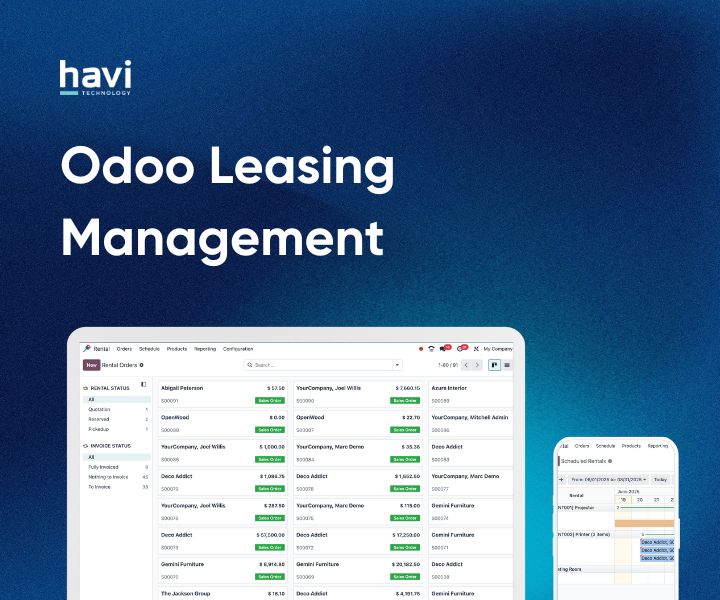TABLE OF CONTENTS
- 1. Website and Customer Experience
- 1.1. Website & eCommerce: Guided Onboarding, New Templates, Google Merchant Sync
- 1.2 Live Chat and Discuss: Expertise Routing, Chat Insights, Status Controls
- 2. Sales, CRM and Subscriptions
- 2.1 Sales: Editable Optional Products, Catalogue Sections, Portal Top-Up
- 2.2. CRM and Marketing: AI Probability, Lead Sources, Kanban Linking
- 2.3. Subscriptions: Prorated Billing, One-Time Sales, Portal Edits
- 3. Inventory, Purchase and Barcode
- 3.1. Inventory and Purchase: Packages within Packages, Forecasted Reports, Suggested Quantity to Replenish
- 3.2. Barcode: Operation Descriptions, Product Source Location, Lot and Serial Number Properties
- 4. Manufacturing, Shop Floor & Planning
- 4.1. MRP: Gantt View, Editable Deadlines, Labour-Based Valuation
- 4.2. Shop Floor & Planning: Barcode Workflows, Shift Scheduling, Routing Edits
- 5. Project, Timesheets and Services
- 5.1. Project and Timesheet: Smart Assign, Mobile Grid View, Priority Alerts
- 5.2. Field Service and Appointments: Calendar View, Technician Tracking, Mass Planning
- 6. HR, Payroll and Expenses
- 6.1. Payroll: Redesigned Engine, Payslip Correction, Unified Master Report
- 6.2. Time Off and Expenses: Odoo Master Cards, Multi-Expense Submission, Complex Duration
- 7. Accounting, Compliance and ESG
- 7.1. Accounting: Peppol Invoicing, Bank Sync, BAS Reports
- 7.2. ESG App: Scope 1–3 Emissions, CSRD Reporting, Auto Category Mapping
- 8. AI, Documents and Sign
- 8.1. AI App: Prompt Commands, Auto Field Completion, Voice and Web Search
- 8.2. Sign and Documents: Bulk Signing, Chatter Integration, Access Controls
- Odoo 19: What’s Coming For Australia?
- 1. Fully compliant Payroll AU with STP Phase 2 and SuperStream
- 2. ABA file payments, Direct Debit for wages/super
- 3. Multi-stream YTD import, backpay, and validations
- 4. 2025–26 tax rules, STSL changes, ATO security
- 5. Peppol invoicing, GST toggle, fringe benefits, BAS automation
- 6. Tyro integration
- 7. Roadmap: SBR BAS lodging, Open Banking, PEL Access, Fiduciary Program
- Odoo 19’s FAQs For Australian Teams
- 1. How should Australian businesses prepare?
- 2. How is Odoo 19 different from Odoo 18 in Australia?
- 3. How can AI in Odoo 19 be tailored for real business outcomes?
- 4. How can I try Odoo 19 or upgrade from my current version?





Odoo Supply Chain Management (SCM) is a suite of integrated Odoo applications that unify procurement, warehouse operations, production, logistics, and sales into one ERP platform. By consolidating these functions, Odoo provides end-to-end visibility, reduces manual processes, and enables faster, data-driven decision-making.
For Australian businesses, these capabilities are particularly significant. Supply chain improvements have the potential to lower consumer prices by 0.4–0.6% (Australasian Railway Association). Yet local complexities — multi-warehouse coordination across states, GST/BAS compliance, and integration with local carriers such as Australia Post, StarshipIT, or TNT — add significant pressure. Odoo meets these needs with a centralised, compliant, and scalable system for both SMEs and larger enterprises.
This article will cover:
What Are the Core Features of Odoo Supply Chain?
Odoo’s Supply Chain suite centralises inventory, procurement, manufacturing, and logistics into a single, connected platform. It streamlines warehouse management, vendor coordination, production planning, shipping, and demand forecasting — helping Australian businesses optimise operations, manage multi-warehouse setups, and ensure GST/BAS compliance. Below shows the core features that make Odoo relevant for Australian businesses.
Inventory and Warehouse Management
Odoo’s inventory module provides end-to-end visibility and traceability across multiple warehouses, product lines, and locations. Businesses can track stock using lot numbers or serial numbers, monitor product moves in real time, and run cycle counts to maintain accuracy.
Procurement and Vendor Management
Odoo Purchase automates procurement with smart reordering rules, supplier lead times, request-for-quotations (RFQs), and landed cost allocation. It links procurement to inventory thresholds, ensuring materials are ordered before stock-outs occur.
Manufacturing and Production Planning
Odoo connects manufacturing operations with supply chain planning through bills of materials (BOMs), work centre routings, subcontracting, and advanced material requirements planning (MRP). This ensures materials, labour, and quality checks align seamlessly with production schedules.
Logistics, Shipping, and Delivery
Logistics in Odoo is managed through structured pick–pack–ship processes, barcode scanning, and real-time warehouse routing. Carrier integrations, including connectors for DHL, FedEx, and local Australian providers for Australia Post or Starshipit, enable direct shipping label generation and tracking updates.
Forecasting and Replenishment
Odoo supports demand forecasting and automated replenishment by combining sales trends and safety stock rules. Businesses can anticipate seasonal peaks, align purchase orders, and balance inventory investment against customer demand.
These features form the foundation of Odoo’s supply chain capability, but their true value is realised when they work together as part of connected processes. The next section will show you how procurement, manufacturing, and logistics flow seamlessly in practice.
Integrated Workflows Across Odoo Supply Chain Modules
Odoo supply chain management is built on connected workflows where sales, inventory, procurement, manufacturing, logistics, and accounting operate as one. Instead of siloed tools, Odoo enables a continuous flow of information across the entire supply chain. The illustration below shows how the core workflows play out in practice.
Convert Sales Orders into Inventory & Production
In Odoo Sales, you can convert sales orders directly into inventory reservations or production requests, depending on stock availability. When stock exists, the system allocates it immediately; when it doesn’t, it triggers a production order or procurement rule. For Australian retailers managing both online and wholesale orders, this guarantees on-time fulfilment without double bookings.
Turn Low Stock Levels into Automated Purchasing
Integrated Odoo Inventory and Purchase modules turn low stock levels into automated purchasing through configurable reordering rules and supplier lead-time calendars. When thresholds are reached, the system automatically generates purchase orders or RFQs to approved suppliers. This prevents costly stockouts and reduces excess inventory — a key advantage for Australian distributors facing long overseas shipping cycles.
Align Manufacturing with Quality & Inventory Updates
Odoo’s Manufacturing, Inventory, and Quality modules keep production, stock, and inspections in sync. Each finished operation automatically updates stock levels and triggers quality inspections where required. For local manufacturers with complex BOMs, this eliminates spreadsheet-based tracking and ensures production data is accurate, traceable, and ready for audit.
Transform Finished Goods into Deliveries & Logistics
Odoo transforms finished goods into deliveries by connecting warehouses to carriers in a structured pick–pack–ship process. Barcode scanning, routing rules, and integration with carriers such as Australia Post or Starshipit allow orders to be processed and shipped with minimal handling.
Connect Supply Chain Flows into Accounting & Compliance
Integration with Odoo Accounting allows every purchase, sale, stock move, or landed cost to be automatically recorded, updating the general ledger in real time. This ensures accurate GST/BAS reporting and smooth reconciliation for Australian SMEs and enterprises.
These workflows show how Odoo transforms fragmented activities into a connected, compliant, and scalable supply chain. Next, we’ll explore how this integration supports Australian business systems and regulatory compliance.
Seamless Integration with Australian Business Systems
Odoo connects its supply chain management modules with third-party platforms and local compliance tools. This ensures that businesses can centralise data, remove manual entry, and operate with a single source of truth across their supply chain.
Integrating Odoo Supply Chain with Sales, CRM, and Accounting
Odoo supply chain works hand-in-hand with Sales, Accounting, and CRM. This built-in integration reduces time spent on admin tasks, improves accuracy, and ensures customer data is consistent across every department.
Australian-Specific Integrations: GST, BAS & Compliance
Odoo’s Accounting and Inventory modules are fully localised for Australian compliance, automatically handling GST, BAS, and tax reporting within standard workflows. This ensures businesses meet ATO requirements while reducing manual work and administrative overhead.
Connecting with Local Couriers and E-commerce
Odoo extends supply chain visibility and automation by connecting directly with shipping providers and online sales channels. This removes the friction between online storefronts, warehouse operations, and carrier partners.
By embedding these connections, Odoo unites the Australian supply chain ecosystem into a single platform, laying the foundation for further innovation and efficiency. In the next section, we’ll learn more about new capabilities for Odoo supply chain management.
New Capabilities for Odoo Supply Chain Management
Beyond integration, Odoo equips businesses with new technologies and tools that extend traditional supply chain management. From AI-driven analytics to sustainability reporting, these tools provide forward-looking visibility and help Australian businesses adapt to emerging priorities.
These new capabilities show how Odoo is adapting to both technological progress and shifting market expectations. The next section explores how Presien have applied Odoo with Havi’s support to achieve measurable results.
A case study of Odoo Supply Chain: How Presien Streamlined Their Supply Chain
Presien, founded in 2020 as a Laing O’Rourke spin-off, focuses on delivering AI-powered safety systems for the construction sector. As a fast-scaling start-up, Presien needed a single, cost-effective ERP system to manage its purchasing, manufacturing, inventory, sales, and finance — all without the complexity of multiple software platforms.
The Challenges Presien Faced
How Odoo Helped Streamline Their Supply Chain
In partnership with Havi Technology, Presien rolled out Odoo within two weeks, achieving seamless data migration and user adoption. Odoo now serves as the core system driving their supply chain and operations.
By centralising its operations on Odoo, Presien operates with the efficiency of a larger enterprise while remaining agile as a start-up. The company continues to scale its operations with Odoo and Havi as the foundation of its supply chain management.
Is Odoo Supply Chain for Australian Businesses?
Yes - Odoo Supply Chain is fully suitable for Australian businesses, including SMEs and mid-market companies. Its modular design lets businesses start with essential modules such as Inventory and Purchase and scale into Manufacturing, Quality, or advanced analytics as they grow. Built-in local compliance for GST, BAS, and ATO reporting, plus integrations with Australian carriers and banking systems, ensures it meets both operational and regulatory requirements.
What sets Odoo Supply Chain apart for Australian SMEs?
Odoo supply chain combines affordability with local compliance and integration capabilities. It handles GST/BAS reporting, ABA bank files, and integrates with carriers, such as Australia Post or Starshipit, making it practical, cost-effective, and aligned with Australian compliance.
What are the benefits for Australian businesses?
Australian businesses benefit from Odoo supply chain through compliance (GST/BAS automation, ATO-ready reporting), operational efficiency (reduced manual work, faster order fulfilment), scalability, and improved customer satisfaction. By consolidating multiple systems into one platform, Australian businesses can focus on growth instead of juggling software.
How does Odoo compare to Microsoft Dynamics 365 for supply chain in Australia?
When it comes to supply chain management, both Odoo and Microsoft Dynamics 365 offer powerful capabilities — but they serve different business needs. Dynamics 365 is built for large enterprises with highly complex, global supply chains. Odoo, on the other hand, is more agile and cost-effective, making it ideal for Australian SMEs and mid-market companies that need a modular, scalable solution with local compliance (GST/BAS, ABA, ATO reporting) built in.
Odoo vs Dynamics 365 — Which Fits Australian Supply Chains Best?
Odoo supply chain provides Australian businesses with a modular, compliant, and AI-driven solution. The right choice depends on your business’s scale, complexity, and budget. Odoo enables fast deployment, easier integration with e-commerce and carriers, and flexibility to grow. Dynamics 365 remains a fit for enterprises with established IT resources. Talk to our experts to determine which platform will best support your supply chain goals.